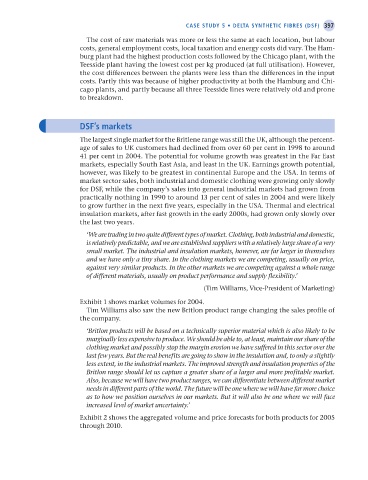Page 422 - Operations Strategy
P. 422
case study 5 • delta synthetic Fibres (dsF) 397
The cost of raw materials was more or less the same at each location, but labour
costs, general employment costs, local taxation and energy costs did vary. The Ham-
burg plant had the highest production costs followed by the Chicago plant, with the
Teesside plant having the lowest cost per kg produced (at full utilisation). However,
the cost differences between the plants were less than the differences in the input
costs. Partly this was because of higher productivity at both the Hamburg and Chi-
cago plants, and partly because all three Teesside lines were relatively old and prone
to breakdown.
dsF’s markets
The largest single market for the Britlene range was still the UK, although the percent-
age of sales to UK customers had declined from over 60 per cent in 1998 to around
41 per cent in 2004. The potential for volume growth was greatest in the Far East
markets, especially South East Asia, and least in the UK. Earnings growth potential,
however, was likely to be greatest in continental Europe and the USA. In terms of
market sector sales, both industrial and domestic clothing were growing only slowly
for DSF, while the company’s sales into general industrial markets had grown from
practically nothing in 1990 to around 13 per cent of sales in 2004 and were likely
to grow further in the next five years, especially in the USA. Thermal and electrical
insulation markets, after fast growth in the early 2000s, had grown only slowly over
the last two years.
‘We are trading in two quite different types of market. Clothing, both industrial and domestic,
is relatively predictable, and we are established suppliers with a relatively large share of a very
small market. The industrial and insulation markets, however, are far larger in themselves
and we have only a tiny share. In the clothing markets we are competing, usually on price,
against very similar products. In the other markets we are competing against a whole range
of different materials, usually on product performance and supply flexibility.’
(Tim Williams, Vice-President of Marketing)
Exhibit 1 shows market volumes for 2004.
Tim Williams also saw the new Britlon product range changing the sales profile of
the company.
‘Britlon products will be based on a technically superior material which is also likely to be
marginally less expensive to produce. We should be able to, at least, maintain our share of the
clothing market and possibly stop the margin erosion we have suffered in this sector over the
last few years. But the real benefits are going to show in the insulation and, to only a slightly
less extent, in the industrial markets. The improved strength and insulation properties of the
Britlon range should let us capture a greater share of a larger and more profitable market.
Also, because we will have two product ranges, we can differentiate between different market
needs in different parts of the world. The future will be one where we will have far more choice
as to how we position ourselves in our markets. But it will also be one where we will face
increased level of market uncertainty.’
Exhibit 2 shows the aggregated volume and price forecasts for both products for 2005
through 2010.
Z05 Operations Strategy 62492.indd 397 02/03/2017 13:42

